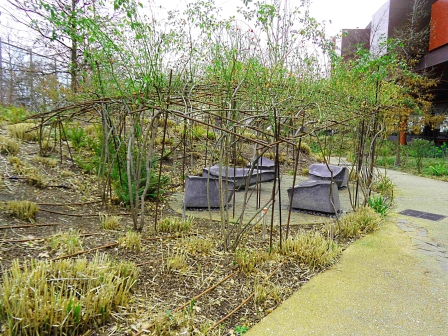
Last weekend, I saw the gardens of the Musée du Quai Branly in Paris. The Musuem was opened in 2006 and is Paris’ newest museum, dedicated to the indigenous art and culture of Africa, Asia, Oceania and the Americas. Jacques Chirac’s parting project from his Presidency, it is a bold and dynamic modern building designed by Jean Nouvel, the great French architect. Wrapped around the building is a large and wandering garden space, protected by glass walls on the river Seine side of the site. The garden space was designed by Gilles Clément, with an extra feature designed by Patrick Blanc, of which more later.
This garden space is open, inclusive and very, very clever. Paths set off with no particular place to go, meandering between curving plantings of magnolia and other human-sized trees, inviting you to weave in amongst the planting without any requirement to obey. The cleverness is created by the sweeping, swerving repeat planting of grasses, euphorbias and other not particularly special plants. Nothing here for the plant snob, which, to my mind, simply evokes movement and freedom from rules. It makes no-one feel small because they don’t know the Latin name of the plant. In fact, I saw no plant tags at all.
I’m not saying that identifying something is intrinsically a problem- just that sometimes in some gardens, identification can verge on the encouragement of snobbery. And in a very public space, where the object is to encourage wandering in the open air and the noticing of natural beauty, such simplicity supports rather than detracts. Sadly, the grasses had just been pruned! But you can imagine….




I didn’t know much about Gilles Clément. I had heard of the Parc André-Citroën in Paris, which he designed in conjunction with Alain Provost, and I am seriously planning on going there later in the year, especially after this last visit. So I read up a little about him. He has been described as one of the most important public space garden designers. His essential view is that nature is not to be messed with, but to be assisted by the gardener as a guide. He speaks for a simpler style, one which engages with human beings, he says,
“…“My gardens are meant to be brushed against…”
And you can feel this in the Museum garden space. It stands out as simple and compelling. Strolling in the garden, these beautiful Magnolia stellata, some white and some the less often-grown pink, were flowering sublimely as the light in the afternoon faded. They were planted close to the path, one even had an obliging manhole cover right next to it that I hopped onto, to get closer. So he meant it about brushing against the garden.


And meantime, back in Tostat, a week later, my Magnolia is just venturing out, looking rather Japanese, I thought.

Thank you for bringing Clement’s exciting and inspiring work to the fore. I can see the charm even in pruned grasses and his ethos of gardens ‘to be brushed against’ rings so true for me. What people often overlook is so well illustrated by your timely post, that a myriad of grasses combine perfectly with woody structures and that gardens as a whole should encourage interaction – throughout the year.
LikeLike
Thanks, yes, hoping to get to Park Andre-Citroen in June….fingers crossed!
LikeLike
The M. stellatas are blooming here too. It looks like a very welcoming garden. The pergola is especially interesting.
LikeLiked by 1 person
The French have always had the edge when it comes to designing brilliant public spaces. They are somehow braver, bolder and more innovative than we are in the UK, although we are catching up slowly with projects like the Olympic Park and the Garden Bridge. Thoroughly enjoyed your account Alison. I almost feel a garden that cannot be brushed against is not a proper garden!
LikeLiked by 1 person
Thank you!
LikeLike